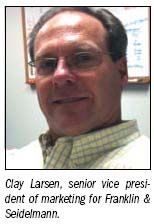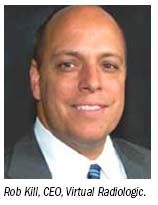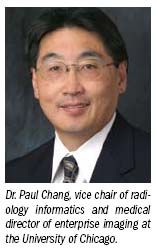Teleradiology day readsshake up the specialty
Teleradiology's aggressive move into day read business gives hospitaladministrators a 'nuclear option' against defiant hospital-based radiologists
If you forgot your hospital administrator's last birthday, make darn sure you don’t next time around.
In fact, you may not need to genuflect before their hospital administrators anytime soon. But a growing trend of teleradiology-minded folks going after the day-read business is eroding perhaps the most powerful bargaining chip for contract negotiation radiologists ever had. The perceived commoditization of imaging interpretations is thus leaving hospital radiologists with few choices: enhance the quality of their services, be nice to hospital CEOs, or get ready to be replaced by day hawks.
Back in June, the Mercy healthcare system in Toledo, OH, shocked the radiology community when it replaced the local radiology group that staffed its three hospitals with an out-of-town practice-management firm that used teleradiology for primary daytime interpretations. According to the Toledo Blade, St. Vincent Mercy Medical Center had been unable to reach a contract agreement with Consulting Radiologists and decided to hire Imaging Advantage, based in Santa Monica, CA.
The relationship between the 19-member radiology group and Mercy hospitals that had endured for over half a century broke up nastily last May. Contract negotiations had been stalled for about a year when Consulting Radiologists got-almost literally-its two-weeks' notice. The radiologists were on the faculty at the University of Toledo, which retaliated by pulling all of its radiology residents from the Mercy hospitals. Radiologists from the former group were offered jobs under Imaging Advantage's supervision, but none stayed. The resulting shortage disrupted mammography, interventional radiology, and other imaging-related services. What was meant to be a seamless transition turned, by some accounts, into an administrative nightmare that left in its wake grieving technologists, disgruntled referring physicians, and widespread turmoil.
Circumstances surrounding the case have been tinged with hearsay and misinformation. In early August, an e-mail attributed to teleradiology company NightHawk Radiology advocating the death of the middlemen, hospital-based radiology groups, incited uproar among radiologists. The note, allegedly in a quarterly report, stated that the best strategy to address recent revenue losses and the need for long-term growth would be “bypassing the radiology groups and working directly with the hospitals.” A stream of comments propagated through the Internet also pointed the finger at the Coeur d'Alene, ID, firm for supposedly having a hand in displacing the Toledo radiology group.
In an Aug. 10 letter addressed to its customers, NightHawk Radiology's president and CEO Dave Engert said all the allegations were false. Engert said the remarks were actually excerpts from a report by an independent analyst and erroneously attributed to NightHawk, which had disowned such a strategy.
“We absolutely do not do that. We don't have any group within our company that does that. We are focused on a business level to provide services to our radiology partners. And we don't compete with our own radiology customers or any radiology group for contracts,” Engert told Diagnostic Imaging.

Engert acknowledged there are situations where NightHawk's radiology customers happen to be competing with one another for a specific hospital contract. This includes radiology groups as well as practice management organizations employing radiologists.
“We have had some situations that may have come across looking like there is a change in our mission and direction, and that's absolutely not true. We are true to our mission,” he said.
The damage was already done, however. Online discussion boards, such as a general radiology forum maintained by online radiology news publication Aunt Minnie, was swarmed with postings from angry radiologists, some of whom advocated boycotting the firm.
Despite the unproven claims, the Toledo case was an eye-opener for radiologists. Traditional teleradiology companies and some of their less conventional brethren may not intend to openly compete with local radiologists, but the indisputable fact is that many in the teleradiology business have been quietly claiming a stake in the day reads market for a long time.
Teleradiology firm Franklin & Seidelmann, based in Cleveland, has had a presence on the remote daytime interpretations market since its founding in 2001. On July 1, Central Michigan Community Hospital became the latest addition to Franklin & Seidelmann's portfolio of customers with full-service radiology coverage. The deal includes around-the-clock preliminary and final interpretations performed remotely by emergency department and other subspecialty radiologists, aided by onsite radiology physician assistants and other medical personnel.
Just a few days later, Virtual Radiologic, a teleradiology company headquartered in Minneapolis, announced a similar arrangement with the National Rural Health Association. That nonprofit organization has nearly 20,000 members and provides services for about 60 million people living in rural communities across the country.
Teleradiology groups sometimes must deal directly with hospitals, some of which are located in remote areas with no access to imaging interpretation services. And even when these hospitals do have some radiologists on staff, the scope of the services they can provide might be limited.
“Our mission is to augment and assist local radiologists and local radiology practices. We don't plan to replace or compete with them,” said Virtual Radiologic CEO Rob Kill.
But it takes two to tango. Hospital administrators have an important role in this trend and it may actually be less subtle than it seems. Administrators may not be actively seeking to replace their radiologists. But that does not mean they aren't looking at the prospects.
“We've been approached by several hospitals that weren't happy with their local radiology practices,” Kill said. “We passed on those opportunities because they were at odds with our mission and we don't believe being used as a wedge in negotiations is beneficial to any party.”
Teleradiology booms
According to Clay Larsen, senior vice president of marketing at Franklin & Seidelmann, multiple factors have led teleradiology firms to pursue the day read business, but competition for its own sake is not one of them. The trend is only a response to a logical, though unintended, effect bouncing off much deeper issues brewing within the hospitals themselves.
“This is about identifying a specific need that we feel qualified to address. If you look at what the needs are out there, clearly hospital medical staff are usually pretty disappointed with the service they get from their radiology groups,” Larsen said.
But teleradiology's vigorous push into the daytime interpretation market has led others to suspect there is little, if anything, casual about it. One factor that has encouraged or even forced teleradiology firms to move in this direction has been the need for growth and expansion of their business, said Joe Moock, CEO of StatRad, a San Diego-based teleradiology provider.
“The preliminary nighttime read market is heavily saturated,” Moock said. “Because some [teleradiology companies] are publicly traded, they are forced to show increasing profits and growth. That naturally leads them to look toward the full hospital contracts in order to grow their businesses.”
Individual investors and analysts now keep a close eye on these companies' performance; And they want to see continued growth and expansion. Although large, the teleradiology market does have a roof. If these companies want to continue selling stock, eventually they are going to look toward competing with their client base, Moock said.
10Q reports for the second quarter of 2009 from both NightHawk Radiology and Virtual Radiologic show a drop in the average price per read. This could be a result, as NightHawk's report suggests, of increased competition in the off-hours market.

Teleradiology is helping drive the corporate growth that Dr. Robert Epstein, president of University Radiology Group, considers essential to combating the factors that challenge a successful radiology practice.
The 80-member University Radiology Group is the professional radiology group practice at the Robert Wood Johnson Medical School in New Brunswick, NJ, but it is not a cozy academic practice. URG has been challenged by the rate cuts from the 2005 Deficit Reduction Act and a New Jersey state ambulatory care tax that grabs 3.5% of its gross revenues.
University Teleradiology was formed to capitalize on URG's size and its ability to provide around-the-clock coverage and expert subspecialty consultation. Its objective is to diversify the group's service portfolio while expanding its geographic influence. To date, its work mainly involves after-hours dictation for trauma services that lack the resources to provide around-the-clock coverage themselves.
“We are working cooperatively with other radiology groups to augment their coverage,” Epstein said. “We have tried not to be predatory.”
Epstein anticipates that University Teleradiology will expand in its reach to states outside of New Jersey and in its placement or employment of board-certified radiologists in other U.S. states or foreign countries.
“There will be winners and losers,” he said. “Teleradiology will help big, powerful groups like ours that can offer subspecialization. It will hurt small groups, the mom-and-pop operations.”
Game changer
The current reimbursement model might have pushed radiologists to focus almost exclusively on image interpretation simply because this is the aspect of their job that comes with a paycheck. And teleradiology, the use of PACS, and other state-of-the-art information technologies have contributed to making highly skilled physicians such as radiologists less accessible and, paradoxically, less valuable to their clinical peers and hospital staff, said Dr. Eliot Siegel, chief of radiology and nuclear medicine at the VA Maryland Health Care System.
“Teleradiology has contributed to commoditization, but it has been able to do that because we radiologists in the community have enabled it,” Siegel said. “It's very difficult to commoditize high-quality patient care, but it is very easy to commoditize just the image interpretation.”
This factor alone might have forever diminished radiologists' bargaining power with their hospitals. When radiologists do not communicate properly with their referring physicians, shy away from training technologists or lecturing peers, or avoid in any way the responsibilities or issues associated with being part of the hospital community and focus instead only on reading images, they are setting themselves up to be ratcheted down, Siegel said.
One result of this is a reduction in their perceived value and power.
“Hospital administrators see themselves in the driver's seat more now than in the past,” said Fred Gaschen, executive vice president of Radiological Associates of Sacramento, CA.
Teleradiology made the opening that allowed this change, but it represents only an interim solution, Gaschen said. In the past, radiologists had more leverage when negotiating for better pay or subsidies from the hospitals. They could always threaten to walk out if they did not get their way and hospitals usually blinked. Now, teleradiology gives administrators the leverage and they know they can use it as a last resort to make up for lost services while they recruit new physicians, Gaschen said.
Until a few years ago, administrators could deal only with the people who lived in their communities. The shortage of radiologists, on the other hand, made it nearly impossible to bring in as many as were needed at any given point. Hospitals had virtually no bargaining power. Technology changed all that, said Imaging Advantage chairman and CEO M. Naseer-Uddin Hashim.
“In the world today, if you are a hospital, you can actually go and talk to companies like ours and see if there are other solutions,” Hashim said.
According to Hashim, although technology and the complexity of patient care have changed exponentially in the last decade, the radiology world remained static. A line was drawn between radiologists who read at night and those who do the job during the day to ensure they never competed, he said. Traditional workflow management strategies required hiring more people to handle the backlogs that occurred only at specific hours of the day. The model was inherently inefficient because it required hiring someone full time to read about a fifth of what a typical full-time–equivalent radiologist would read.
Thanks to technology advances, now anybody who meets licensing and credentialing rules can be in the teleradiology business, Hashim said. Such disruptive technology has infiltrated hospitals, it has made the practice of radiology more flexible and ubiquitous, and it cannot be stopped. Radiologists thus have only two choices: They can despise it or they can embrace it, he said.
“I'm not on the side of the hospitals. I am simply trying to create a better use of the technology and the dynamic situation that exists in the marketplace today,” he said.
Protecting practice
No hospital would actively seek to replace its radiologists unless it was truly unhappy with them. During a bad economy, administrators have to look for ways to reduce costs and, besides leverage, teleradiology now gives them another way to pinch pennies. Although replacing an entire radiology group could prove a daunting task, the possibility of their work being outsourced is hanging in the air and now more than ever radiologists need to know what makes them vulnerable.

“Usually, hospitals are unhappy with their radiologists because of service issues,” said Dr. Lawrence R. Muroff, president and CEO of Imaging Consultants.
According to Muroff, specific service issues include an unwillingness to accommodate service requests from referring physicians, or failure to meet patients' needs or respond to legitimate requests from the administration.
In many cases, it involves cost-cutting strategies sought by hospital administrators, such as avoiding transcriptionists and asking radiologists to edit their reports themselves. Unfortunately, the issue remains contentious because such measures always bear economic implications for somebody.
Turnaround speed also can affect the decision. Teleradiology poses a particular threat to groups that cannot perform basic imaging tasks, such as cross-sectional imaging, in real-time, said Dr. J. Raymond Geis, a radiologist at Advanced Medical Imaging Consultants of Fort Collins, CO.
“That's basic. If you aren't doing that 24/7, then you really are vulnerable to the teleradiology groups being able to offer better service,” Geis said.
Teleradiology companies are not the only threat. Sometimes, hospitals administrators need go no farther than their own counties to get the services they need. In June, the board of trustees for the Natchez Regional Medical Center in Natchez, MS, decided to end a 50-year relationship with Radiology Associates, the oldest radiology group in the historic town. The medical center decided to contract out with Comprehensive Radiology Services, a 17-member radiology group in Hattiesburg, 125 miles southeast of Natchez. The trustees were assured that by contracting with CRS, turnaround would be cut to two hours.
Subspecialty reads also come into the equation. Radiology groups working for hospitals that have orthopedists or neurosurgeons or pediatricians have to be able to meet this subspecialty reading need, Geis said.
“That's tough to deal with if you're only a four- or five-person group-or even a 10-person group-to have somebody around all the time who's a specialist. So that's an issue.”
There are those who see this, however, as a true opportunity for radiologists. According to Dr. Paul Chang, vice chair of radiology informatics and medical director of enterprise imaging at the University of Chicago and a pioneer in PACS, many radiology groups will end up being outsourced. There are many more, however, that will realize they can be truly collaborative value providers. These groups will adopt electronic tools to leverage services to their hospitals and will, in the end, be able to offer these services to outside customers, just like teleradiology firms do, he said.
“They will have to embrace exactly the same technology as the teleradiology groups do and be able to provide services to other groups,” Chang said. “The whole overall quality of radiology will improve and the question of whether it is provided remotely or locally will become less important than the quality of the service.”
GE HealthCare Debuts AI-Powered Cardiac CT Device at ACC Conference
April 1st 2025Featuring enhanced low-dose image quality with motion-free images, the Revolution Vibe CT system reportedly facilitates improved diagnostic clarity for patients with conditions ranging from in-stent restenosis to atrial fibrillation.
Predicting Diabetes on CT Scans: What New Research Reveals with Pancreatic Imaging Biomarkers
March 25th 2025Attenuation-based biomarkers on computed tomography (CT) scans demonstrated a 93 percent interclass correlation coefficient (ICC) agreement across three pancreatic segmentation algorithms for predicting diabetes, according to a study involving over 9,700 patients.
Can Photon-Counting CT be an Alternative to MRI for Assessing Liver Fat Fraction?
March 21st 2025Photon-counting CT fat fraction evaluation offered a maximum sensitivity of 81 percent for detecting steatosis and had a 91 percent ICC agreement with MRI proton density fat fraction assessment, according to new prospective research.